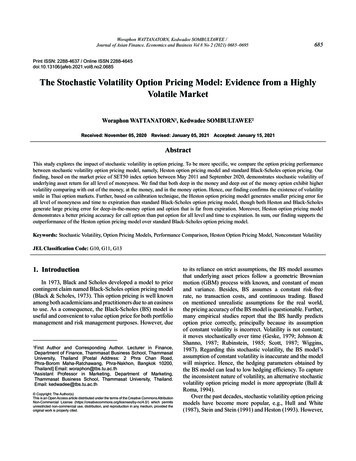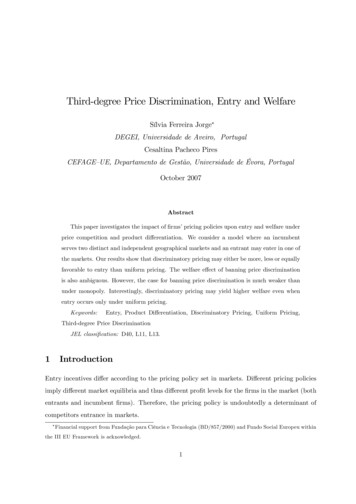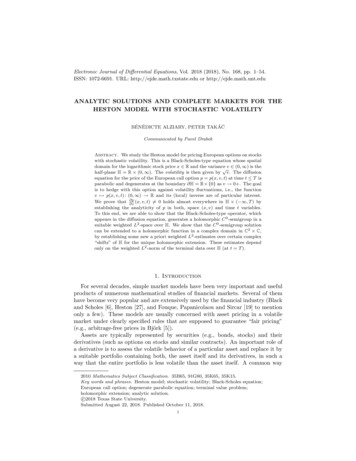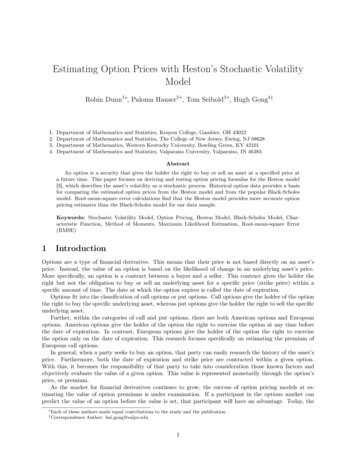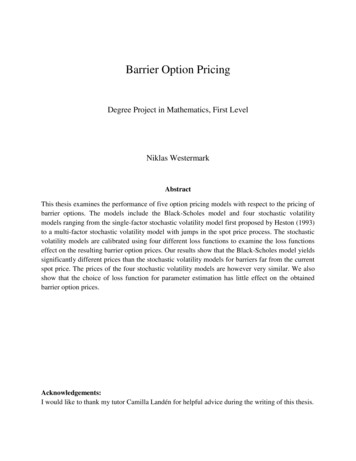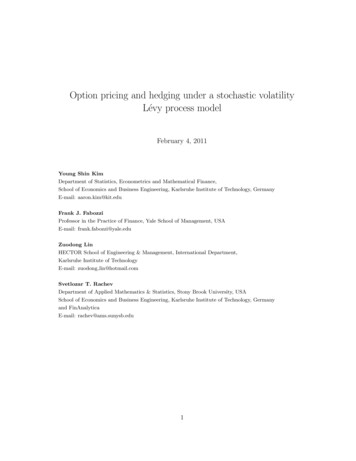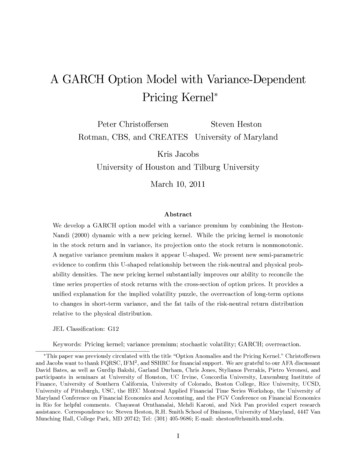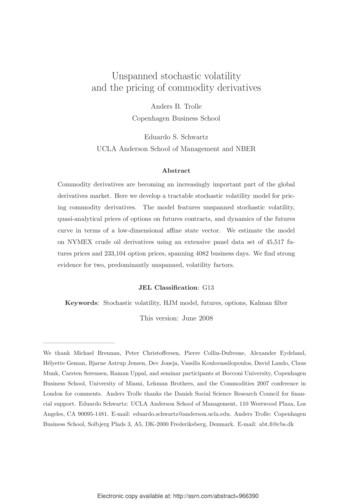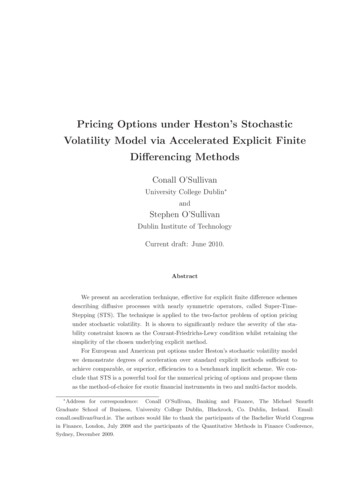
Transcription
Pricing Options under Heston’s StochasticVolatility Model via Accelerated Explicit FiniteDifferencing MethodsConall O’SullivanUniversity College Dublin andStephen O’SullivanDublin Institute of TechnologyCurrent draft: June 2010.AbstractWe present an acceleration technique, effective for explicit finite difference schemesdescribing diffusive processes with nearly symmetric operators, called Super-TimeStepping (STS). The technique is applied to the two-factor problem of option pricingunder stochastic volatility. It is shown to significantly reduce the severity of the stability constraint known as the Courant-Friedrichs-Lewy condition whilst retaining thesimplicity of the chosen underlying explicit method.For European and American put options under Heston’s stochastic volatility modelwe demonstrate degrees of acceleration over standard explicit methods sufficient toachieve comparable, or superior, efficiencies to a benchmark implicit scheme. We conclude that STS is a powerful tool for the numerical pricing of options and propose themas the method-of-choice for exotic financial instruments in two and multi-factor models. Address for correspondence:Conall O’Sullivan, Banking and Finance, The Michael SmurfitGraduate School of Business, University College Dublin, Blackrock, Co. Dublin, Ireland.Email:conall.osullivan@ucd.ie. The authors would like to thank the participants of the Bachelier World Congressin Finance, London, July 2008 and the participants of the Quantitative Methods in Finance Conference,Sydney, December 2009.
1IntroductionThe Black-Scholes partial differential equation (PDE), Black & Scholes (1973) and Merton(1973), laid the foundations for modern derivatives pricing. However the assumptionsmade in the Black-Scholes model are known to be overly restrictive. In particular, theBlack-Scholes model assumes that the underlying asset price follows a geometric Brownianmotion with a fixed volatility.Many derivative pricing models have been developed subsequently which use more sophisticated stochastic processes for the underlying asset which result in a better match toempirically observed details.Using such stochastic processes is often more straightforward than relaxing the BlackScholes assumptions to allow for discrete time trading, transactions costs and other market imperfections. Examples of more realistic stochastic processes include: jump-diffusion(Merton, 1976); Lévy (Cont & Tankov, 2004); stochastic volatility (SV) (Heston, 1993);stochastic volatility jump-diffusion (Bates, 1996); and also combinations of these that exhibit SV as well as jumps in both the asset price and volatility (Duffie et al., 2000).In many of these cases there may be no analytical solution to the PDE describing thecorresponding vanilla European option price. The PDE describing the American analogdoes not have a closed form solution in any of these models.When a closed form solution does not exist one popular way to proceed is to solvethe PDE numerically using finite difference (FD) methods, see Wilmott et al. (1993) andTavella & Randall (2000).Despite their increased complexity numerical valuations of options using FD methodsbased on implicit discretizations are usually superior in terms of efficiency to approachesbased on conventional explicit discretizations. The principal reason for this is the CourantFriedrichs-Lewy (CFL) stability constraint on explicit schemes which limits the size ofthe time step relative to the square of the spatial step size. In this paper, the restriction that the CFL constraint imposes is reduced significantly using an acceleration technique for explicit algorithms known as Super-Time-Stepping (STS). STS was recently introduced to the finance literature for the first time in the one-factor Black-Scholes settingby O’Sullivan & O’Sullivan (2009) for vanilla European and American put options.While the behaviour of STS has only been analytically established for symmetric operators Alexiades et al. (1996), O’Sullivan & O’Sullivan (2009) described the implementation2
of a novel splitting approach to treating non-symmetric operators. This splitting method isbased on the unique decomposition of the operator into its symmetric and skew-symmetricparts. The former may then be treated via STS while the latter is efficiently integratedvia a suitable scheme in a procedure introduced by O’Sullivan & Downes (2006, 2007). Inthis way, O’Sullivan & O’Sullivan (2009) demonstrated formal stability for the acceleratedscheme and showed that the splitting procedure is unnecessary in the case of a weaklynon-symmetric operator.In this work, we follow that precedent and do not split the operator. As will be shown,for the problems under consideration here, the performance of STS does not appear tosuffer any discernable adverse implications to its stability properties as a result.The contribution of this paper to computational finance is to extend the applicationof the STS acceleration technology to the two-factor problem of pricing European andAmerican put options under Heston’s SV model. STS is compared to a number of standardFD methods used frequently in the literature for SV options pricing. We demonstrate thatthe efficiencies attained using the STS algorithm are comparable, and often superior, tothose of common implicit differencing techniques. Crucially, this acceleration is achievedwithout any significant increase in implementation complexity relative to the underlyingstandard explicit scheme.There exist many methods to numerically solve European and American style optionsusing the PDE approach. Successive overrelaxation (SOR) is the most popular iterativemethod for obtaining the solution in the European option case (see Crank (1984) for details)while projected SOR (PSOR) (PSOR) (Cryer, 1971) is one of the most popular methodsused to solve higher dimensional linear complementarity problems (LCPs) that result frompricing American options. With (P)SOR, as we refine the computational grid to obtainmore accurate option prices the number of iterations required to converge grows, howeverthis effect can be reduced by appropriate (problem dependent) tuning of the overrelaxationparameter.Other approaches used to numerically solve the option pricing PDE under the SV modelof Heston include: an ILU pre-conditioned conjugate gradient method with a penalty termdevised by Zvan et al. (1998) to handle the early exercise feature of American options; amultigrid method used by Clarke & Parrot (1999) and Oosterlee (2003) to price Americanoptions; a Hopscotch scheme applied by Kurpiel & Roncalli (2000) to price American options; a finite element approach constructed by Winkler et al. (2001) to price European and3
barrier options.A number of schemes used to solve LCPs were also compared by Ikonen & Toivanen(2007a,b) including a PSOR method, a projected multigrid method, an operator splittingmethod and a component wise splitting method. All of the schemes examined by theseauthors displayed varying levels of superiority over the PSOR method in efficiently pricingAmerican options under the SV model.All of the methods mentioned above, with the exception of the Hopscotch method whichis a mixed implicit-explicit method, are implicit algorithms which are faster but significantlymore complex in their implementation than their explicit differencing cousins. In particular,these methods are global in the sense that the entire solution must be available in order toadvance any point and are therefore inherently difficult to parallelize.The crucial difference in the STS algorithm allows explicit FD schemes to become viablealternatives to their implicit counterparts. The relative simplicity of explicitly differencedPDEs is inherited by the scheme including the local nature of the FD stencil. Parallelizationis therefore a trivial endeavor in this context.This paper is arranged as follows.Section II reviews Heston’s SV model, the corresponding PDEs describing vanilla European and American option prices, and the associated boundary conditions. Section IIIdescribes the implementation details required to construct the spatial (asset price and variance) grid and reviews the standard FD schemes used to benchmark the STS implementation employed. Section IV introduces the STS technique. The application of STS to optionpricing under SV is the main contribution of the paper. Section V contains comparativetimings and discussion of results. Finally, in Section VI, we offer concluding remarks.2ReviewThis section provides a review of the option pricing PDE and associated boundary conditions for both European and American options under Heston’s SV model.4
2.1Heston’s Stochastic Volatility ModelHeston’s risk neutral SV model can be written as follows: yt xt dzt , dyt {α (β yt ) λγ yt } dt γ yt dwt ,dxt rxt dt (1)ρdt dzt dwt ,where xt and yt are the asset price and variance at time t respectively, r is the risk-freerate, α is the mean reversion of the variance, β is the long run mean of the variance, γ isthe volatility of the variance, ρ is the correlation of the asset price and the variance and λis the market price of risk. We denote by u(x, y, τ ) an option price with a time-to-maturityof τ T t where t is the observation time and T is the expiry.2.2European Put OptionsEuropean options satisfy the following PDE under these asset price dynamics:Lu u Au 0, τ(2)where L is a generalised Black-Scholes type operator and A is its spatial component definedby11 Au yx2 uxx ργyxuxy γ 2 yxuyy rxux {α (β y) λγ y} uy ru.22(3)The payoff, or initial condition, on a Eurpoean put option isu(x, y, 0) g(x, y) max [E x, 0] .(4)European put options satisfyu(0, y, τ ) e rτ g(0, y)(5)on the boundary of x 0.The PDE on the boundary y 0 reduces toLu u u Au rxux αβuy ru 0. τ τ5(6)
We use the following asymptotic boundary conditions at x and y : u(x, y, τ ) 0;x xlimlimy u(x, y, τ ) 0. y(7)(8)This is the equivalent system to that described by Clarke & Parrot (1999), Ikonen & Toivanen(2007b), Oosterlee (2003) and Zvan et al. (1998).2.3American Put OptionsAmerican options may be excercised early thereby demanding the price u must at least beas large as the early exercise value g. This leads to the early exercise constraint u(x, y, τ ) g(x, y).In the continuation region where the contraint is inactive u satisfies the same PDE asthe European option i.e. Lu 0 as given by Eq. 2.Combining these relations we can write the American option pricing problem as a timedependent LCP (for example see Ikonen & Toivanen (2007b)) Lu g, u g, (Lu) (u g) 0,(9)in a domain {(x, y, τ ) x 0, y 0, τ [0, T ] }.Note that the payoff or initial condition of the American put option is the same as theEuropean option.At x 0, the pertinent boundary condition isu(0, y, τ ) g(0, y).The linear complementarity conditions on the boundary y 0 are Lu u Au u rxu αβu ru g, u g,xy τ τ (Lu) (u g) 0.(10)(11)The boundary conditions at x and y are the same as those for the Europeanput option as given by Eq. 7 and Eq. 8.6
3Implementation DetailsIn this section we provide the implementation details of the FD methods considered in thiswork.Following Ikonen & Toivanen (2007b), we use grid generating functions to increase computational efficiency by decreasing the density of mesh points away from regions of interest.We also employ upwinding when the PDE becomes convection dominated to avoid spurious oscillations in these regions as described by Ikonen & Toivanen (2007b). Unlike theseauthors, however, we use a conventional nine point stencil as opposed to their seven pointprescription.3.1Spatial Discretization on Non-Uniform GridsThe FD discretizations are constructed on a non-uniform grid(xi , yj , τk ) {0 x0 , . . . , xm X} {0 y0 , . . . , yn Y } {0 τ0 , . . . , τl T } . (12)Standard FD methods are used to discretise the spatial operator A in Eq. 3. CentredFD is used for the diffusion terms and, in most cases, for the convection terms. However,at certain boundaries, and in areas where convection dominates over diffusion, upwindingis beneficial and one-sided differences are used. More details on the discretization schemeused at the boundaries and on the implementation of upwinding techniques are given in Aand B respectively.We now present a nine point stencil with respect to a reference point (xi , yj ).The spatial intervals used in the discretization are then given ashl xi xi 1 ,hr xi 1 xi ,hd yj yj 1 ,and hu yj 1 yj .(13)For clarity of notation from this point on we denote u (xi , yj ) as ui,j .The central FD schemes used for the diffusion components at the inner points of the7
computional mesh (away from the boundaries) are 2uDD aDl ui 1,j a ui,j ar ui 1,j , x2 2uDD bDd ui,j 1 b ui,j bu ui,j 1 , y 2 2uDD cDld ui 1,j 1 cl ui 1,j clu ui 1,j 1 x y(14)DD cDd ui,j 1 c ui,j cu ui,j 1DD cDrd ui 1,j 1 cr ui 1,j cru ui 1,j 1 ,where 222, aD , aD,r hl (hl hr )hl hrhr (hl hr )2 22bD, bD , bD,u d hd (hd hu )hd huhu (hd hu )aDl C CcDld al bd ,C CcDl al b ,C CcDlu al bu ,C CcDd a bd ,cD aC bC ,C CcDu a bu ,C CcDrd ar bd ,C CcDr ar b ,C CcDru ar bu .(15)The FD schemes used for the convection components at any inner points of the computional mesh where upwinding is not necessary are uCC aCl ui 1,j a ui,j ar ui 1,j , x uCC bCd ui,j 1 b ui,j bu ui,j 1 , y(16)wherehr hlhl hr, aC , aC,r hl (hl hr )hl hrhr (hl hr ) huhu hdhdbC, bC , bC.u d hd (hd hu )hd huhu (hd hu )aCl (17)Substituting these approximations into Heston’s PDE for European options, Eq. 2, we8
have 1 2 D1yx a ργyxcD γ 2 bD rxaC α (β y) bC22 1 2 DCD yx al ργyxcl rxal ui 1,j2 1 2 DDCyx ar ργyxcr rxar ui 1,j 2 1 2 DCD ργyxcd γ bd α (β y) bd ui,j 12 1 2 DCD ργyxcu γ bu α (β y) bu ui,j 12 D ργyxcDld ui 1,j 1 ργyxclu ui 1,j 1 D ργyxcDrd ui 1,j 1 ργyxcru ui 1,j 1 0. u τ ui,j(18)The governing PDE may then written compactly asLu u Au 0, τin which A is a nine component operator matrix Alu Au A Al AcAld AdwithAcAlArAdAugiven by Aru Ar ,Ard(19)(20) 1 2 D1 2 DDCC yx a ργxyc γ yb rxa α (β y) b r ,22 1 2 DDC yx al ργxycl rxal ,2 1 2 DDCyx ar ργxycr rxar , 2 1 2 DDCγ ybd ργxycd α (β y) bd , 2 1 2 DDCγ ybu ργxycu α (β y) bu , 2Ald ργxycDld ,Ard ργxycDrd ,Alu ργxycDluAru ργxycDru .9(21)
We have relegated discussion of the discretization techniques employed at the boundariesto A, and on the interior in zones where upwinding is necessitated by the dominance ofconvection effects in the solution to B.The approach described above is easily applied to the case of American options as givenby the time dependent LCP Eq. 9.3.2Grid Generating FunctionsGrid generating functions are used to increase the density of the computational nodesaround regions of importance in order to increase the efficiency of the method i.e. to reacha desired accuracy level with less grid points. The grid in the x direction is constructedaccording toxi 1 xi hr (xi ) for i 0, . . . , m,(22)with the functional form used for the grid generating function in the x direction, hr (xi ),given by: p chr (xi ) E sinh pxi arcsinh Efor i 0, . . . , m.pc(23)as described by Kluge (2002).This grid generating function increases the number of nodes around the exercise price E.The parameter c controls the density of the grid points close to E relative to the density ofPthe grid points at xmax . The parameter p is obtained by requiring x0 mi 1 hr (xi ) xmaxand solving numerically for p.By way of illustration, Figure 1(a) depicts the non-uniform grid step size versus thestock price for x0 0, xmax 20, m 128, p 0.2177 and c 0.5. These parametersresult in a ratio of step sizes in the x-direction at xmax and E of 4.3939.In the y direction a linear grid generating function, hu (yj ), is used whereyj 1 yj hu (yj ) for j 0, . . . , n.(24)The grid generating function hu (yj ) increases the density of grid points at low variancevalues relative to high variance values and is specified byhu (yj ) q j/n 1yj for j 0, . . . , n.q 110(25)
The parameter q is chosen to ensure that a given reference value in variance occurson some point on the grid, yk . For the tests under consideration in this work we chooseyk 0.0625 or yk 0.25.Figure 1(b) plots the non-uniform grid step size against the variance y for yk 0.0625, n 64 and q 4.0734. In this illustrative case, the ratio of step sizes in the y-direction at ymaxand yk is 2.1566.3.3Time DiscretizationIn this section the explict, implicit and Crank-Nicolson (CN) time discretization methodsare briefly described.The Heston PDE for European options over the entire solution space can be written as u Au 0, τ(26)where A is a block tridiagonal (m 1)(n 1) (m 1)(n 1) matrix, u is a vector of length(m 1)(n 1), m is the number of steps in the x direction and n is the number of steps inthe y direction. The vector u and tridiagonal matrix A are constructed by stacking eachsolution uij and corresponding nine component operator matrix A into a column vectorand block tridiagonal matrix respectively, for i 0, . . . , m and j 0, . . . , n.We begin by introducing the θ-method of discretization. Applied to Eq. 26 we obtainu(k 1) u(k) θAu(k 1) (1 θ) Au(k) 0 τ (I θ τ A) u(k 1) (I (1 θ) τ A) u(k) 0, for k 0, 1, . . . , l 1.This can be written more compactly asBu(k 1) Cu(k) 0,(27)where B I θ τ A and C I (1 θ) τ A.For American options the scheme in Eq. 27 becomes a time dependent LCP as describedin Eq. 9 Bu(k 1) Cu(k) , u(k 1) g Bu(k 1) Cu(k) T u(k 1) g 0,11(28)
where g is the early exercise value of the option.When θ 0 the θ-method corresponds to the explicit Euler scheme. This schemeis first order accurate in time and second order accurate in space. The Euler scheme isvery simple to implement, however, stability depends on the size of the time step whichis in turn dictated by the spatial step size and the coefficients of the governing PDE (seeWilmott et al. (1993); Tavella & Randall (2000) for further details). In particular whencorrelation ρ 0, the theoretical upper limit on the time step is given by "# 1 x2 y 2γ yji j τexpl min .20 i m h (x ) h (yj )2i(29)0 j nIn the more general case of non-zero correlation Eq. 29 is found to be an effective estimateof the critical upper limit on the time step in the test cases considered in this paper.This constraint on the time step is known as the Courant-Friedrichs-Lewy (CFL) stabilityconstraint and can be severely restrictive.When θ 1 the θ-method corresponds to the fully implicit scheme. The fully implicitscheme is first order accurate in time, second order accurate in space and has no limitationson the size of the time-step for stability, however, the desired accuracy of the solution stillimposes a constraint on the minimum number of time steps that may be used.An alternative approach frequently used in the literature is the CN scheme which corresponds to θ 1/2. The CN scheme is second order accurate in time and space. Similarlyto the fully implicit method, CN has no limitations on the size of the time-step for stability.However the CN method can lead to solutions with spurious oscillations if the initial valueis not smooth (which is the case for option payoffs). To alleviate this problem Rannacher(1984) time-stepping is typically used in the CN algorthim1 .In the fully implicit and CN schemes, LCPs can be solved iteratively at each timestep by employing any of a number of methods including PSOR, projected multigrid,and the penalty method (see Clarke & Parrot (1999); Oosterlee (2003); Ikonen & Toivanen(2007b)). Direct methods also exist such as the formulation presented by Ikonen & Toivanen(2007b) of the Brennan & Schwartz (1977) UL decomposition algorithm.1Rannacher time-stepping is where the first few time steps are performed with the fully implicit schemewith a time step size of τ /2 and thereafter the time steps are performed with the CN scheme with a timestep size of τ . We use the first four steps with the implicit scheme and the remaining l 4 steps with theCN scheme.12
We elect CN with PSOR, denoted CN-PSOR, as the standard benchmark scheme forcomparison with the proposed STS approach in tests solving Eq. 28. CN-PSOR is a suitablechoice due to its competitive performance with respect to other methods and its widespreadusage (e.g. Tavella & Randall (2000); Wilmott et al. (1993)). A short description of thePSOR algorithm is included in C for the reader’s reference.The equation for the European option price, Eq. 2, may be solved analytically (Heston,1993). However, as analytical solutions do not exist in general for exotic options withEuropean payoff functions, we test the efficacy of STS with respect to CN-SOR, a CNscheme iteratively solved via simple successive overrelaxation (SOR).Finally, the standard explicit scheme to first order accurate in time, denoted EXPL-1,is included in the tests to assess the relative acceleration achieved by STS over its basescheme in both the American and European cases.4Super-Time-SteppingIn the previous section we reviewed a number of well known time discretization approachesfrequently used in FD methods for the integration of time-dependent PDEs. This sectionintroduces an alternative time discretization method known as super-time-stepping (STS)which can be used to accelerate conventional explicit schemes for parabolic problems withnearly symmetric positive definite evolution operators.In the following, we shall use the description of Alexiades et al. (1996), itself a variant ofa method presented by Gentzsch (1979), which is in turn essentially a pared-down RungeKutta-Chebyshev (RKC) method (van der Houwen (1977); van der Houwen et al. (1980);Verwer et al. (1990); Verwer (1996); Sommeijer et al. (1997)).Despite the fact that the STS method is approximately 30 years old, it has been reportedin use by relatively few researchers. The instances in the literature of STS being used whichwe are aware of are in engineering and physical disciplines. These include: nonlinear degenerate convection-diffusion Evje et al. (2001); electromagnetic wave scattering Shi et al.(2006); isotropic and anisotropic diffusion on biological membranes Sbalzarini et al. (2006);and magnetic field diffusion in astrophysics O’Sullivan & Downes (2007); Mignone et al.(2007). Recently, STS has been applied in finance and rigorously tested for the BlackScholes pricing model by O’Sullivan & O’Sullivan (2009) where it was shown to be comparable, and in many cases superior, to the CN-SOR/CN-PSOR scheme in terms of accuracy13
and computional speed for European/American put options.To proceed we consider the PDE u Au 0; τu (0) u0 ,(30)and we assume a linear explicit scheme on u R(m 1)(n 1) of the formuk 1 (I τsts A)uk(31)where the solutions at time levels k and k 1 are known and unknown respectively, I is theidentity matrix and A R(m 1)(n 1) R(m 1)(n 1) is a symmetric positive definite matrix.Eq. 31 corresponds to the θ 0 instance of the θ-method corresponding to the explicitEuler scheme as described in Section 3.3. For stability the CFL contraint requires that 1 τ λ 1(32)for all eigenvectors λ of A. The maximal value of τ may therefore be defined by τexpl 2(33)λmaxwhere λmax is the largest eigenvalue of A.The essence of STS is that rather than requiring stability at each step of the timeintegration, Nsts sub-steps of varying size τj (j 1 to Nsts ) are rolled together into asingle super-step τsts according to τsts NstsX τj .(34)j 1and stability is only demanded at the end of the super-step 2 . We write the compoundscheme as NstsY2uk 1 j 1 (I τj A) uk(35)Verwer (1996) has claimed that factorized RKC methods are impractical as they suffer from internalinstability. O’Sullivan & O’Sullivan (2009) find no evidence of any such instability influencing their solutionsfor cases with Nsts 30.14
and for stability we requireNstsYj 1(1 τj λ) 1(36)for all eigenvectors λ of A.The properties of Chebyshev polynomials of degree Nsts (Markoff, 1916) provide themeans to explicitly enforce stability while maximizing τsts . The optimal values for thesub-steps obtained in this way are given by τj τexpl ( 1 ν) cos 2j 1 πNsts 2 1 ν 1(37)where ν is a user defined damping factor. The scheme is stable for ν 0 and unstable inthe limit ν 0 with the property2 τsts Nsts τexplas ν 0.(38)In practice the scheme may be marginally stable for low enough values of ν for a givenchoice of Nsts . A balance between robustness and acceleration should therefore be struckby the user with appropriate choices of the two free parameters.We illustrate the efficacy of the acceleration process for Nsts 30 in Figure 2 for variouschoices of ν. It can be seen that the first substep may be up to 25 times the stable limitfor a standard explicit integration as ν 0 but subsequent substeps become small. Theeffect of this is a cumulative error cancellation which recovers stability over the compositesuperstep. Crucially, there is a net payoff in terms of the size of the superstep with respectto Nsts steps of size texpl according to equation 38.STS applied directly as described above results in a scheme which is first order intime (Alexiades et al., 1996). From this point we shall refer to this scheme as the STS-1scheme. It is not possible to introduce additional temporal structure to an STS step sinceintermediate values obtained during an STS cycle are physically meaningless and may notbe used as approximations to the solution in any sense. Therefore, predictor-corrector stylemethods are not applicable should higher order convergence be required. On the otherhand, we have found that Richardson extrapolation (RE) works well. By this method15
all the advantages of the STS-1 method are easily transferred to second (or higher) orderschemes.The principal advantage of the STS method is not efficiency however, but simplicity.Explicit discretizations of even the most complex systems of parabolic equations are verystraightforward within this discretization paradigm. In particular, implementation of adaptive mesh refinement (AMR) technologies and/or parallelization via domain decompositiontechniques present no great challenges from within an explicit framework. On the contrary, when implicit methods are involved, tackling problems of even a moderate level ofcomplexity can be an exceedingly intricate task, especially in parallel applications.Note that although formal results only exist for linear schemes, there is ample evidence,as described above, that non-linear target systems may be equally amenable to the STSmethod. Formally, stability of the STS scheme is assured if A in equation (35) is symmetricpositive definite, Alexiades et al. (1996). However, in the Black Scholes PDE and the moregeneral Heston PDE the spatial operator A is weakly non-symmetric.In the Black Scholes case a formal stability analysis for an alternative discretization ofthe non-symmetric Black Scholes spatial operator A is given in O’Sullivan & O’Sullivan(2009). The scheme presented therein is formally stable under application of STS to thesymmetric component of the multiplicitavely split operator. The skew symmetric partof the operator is then integrated via a novel scheme developed by O’Sullivan & Downes(2006, 2007). While the split scheme presented by O’Sullivan & O’Sullivan (2009) is formally stable and may be of particular interest for systems with moderate to strong skewsymmetric evolution operators, it was found by these authors that this alternative schemewas not strictly necessary for weakly non-symmetric operators. In agreement with thisresult, we find that splitting is unnecessary and that direct application of the STS schemeto the Heston PDE is appropriate even though the Heston spatial operator A is not fullysymmetric.Before comparing the performance of the STS method applied via equation (35) to theFD schemes described in Section 3.3 we include a brief section on the use of RE in the STSscheme.16
4.1Richardson ExtrapolationIn this paper we employ two RE methods to render STS schemes second order accurate intime.The first approach is to use RE in a step-wise fashion. We assume a smoothly convergentfirst order accurate method for the temporal integration of the semi-discrete equation (30)with exact solution u x, y (x, y, τ ) on a grid with spatial intervals x, y. Given a secondorder accurate solution at time level k such that uki,j u x, y (i x, j y, k τ ) (L k)O( τ 3 ) we may take a single step of size τ to approximate the solution at time level23k 1 using uk 1ij ( τ ) u x, y (i x, j y, (k 1) τ ) C τ O( τ ) for some constant Cdetermined by the leading truncation error term of the scheme. Similarly, taking two steps23of size τ /2, we have uk 1ij ( τ /2) u x, y (i x, j y, (k 1) τ ) (C/2) τ O( τ ).k 1Subtracting the expression for uk 1ij ( τ ) from twice the expression for uij ( τ /2) yieldsa second order advancement in the solution from time level k to level k 1 according tok 1uk 1 2uk 1ijij ( τ /2) uij ( τ ), for k 0, 1, . . . , l 1.(39)We also consider the more usual post-processed form which requires two independentlyderived solutions for use in the extrapolation of the final solution ulij 2ulij ( τ /2) ulij ( τ ), see for example Geske & Johnson (1984).We refer to the former approach as local RE and the latter as global RE. The significantdifference is that, for local RE, a second order solution is immediately available at everytemporal mesh point. For global RE, this would require significant additional data storageand handling. However,
stochastic volatility jump-diffusion (Bates, 1996); and also combinations of these that ex-hibit SV as well as jumps in both the asset price and volatility (Duffie et al., 2000). In many of these cases there may be no analytical solution to the PDE describing the corresponding vanilla European option price. The PDE describing the American analog
